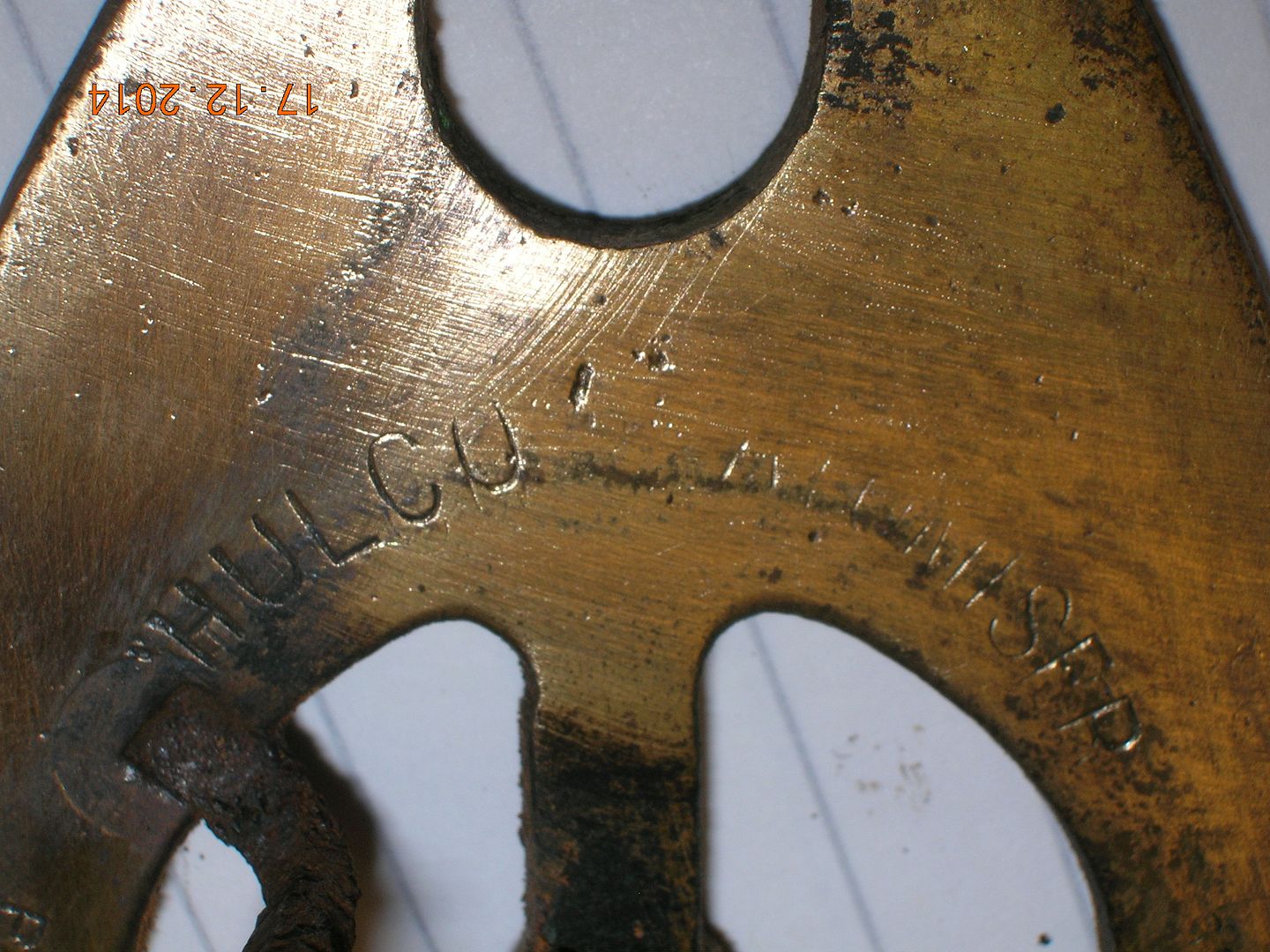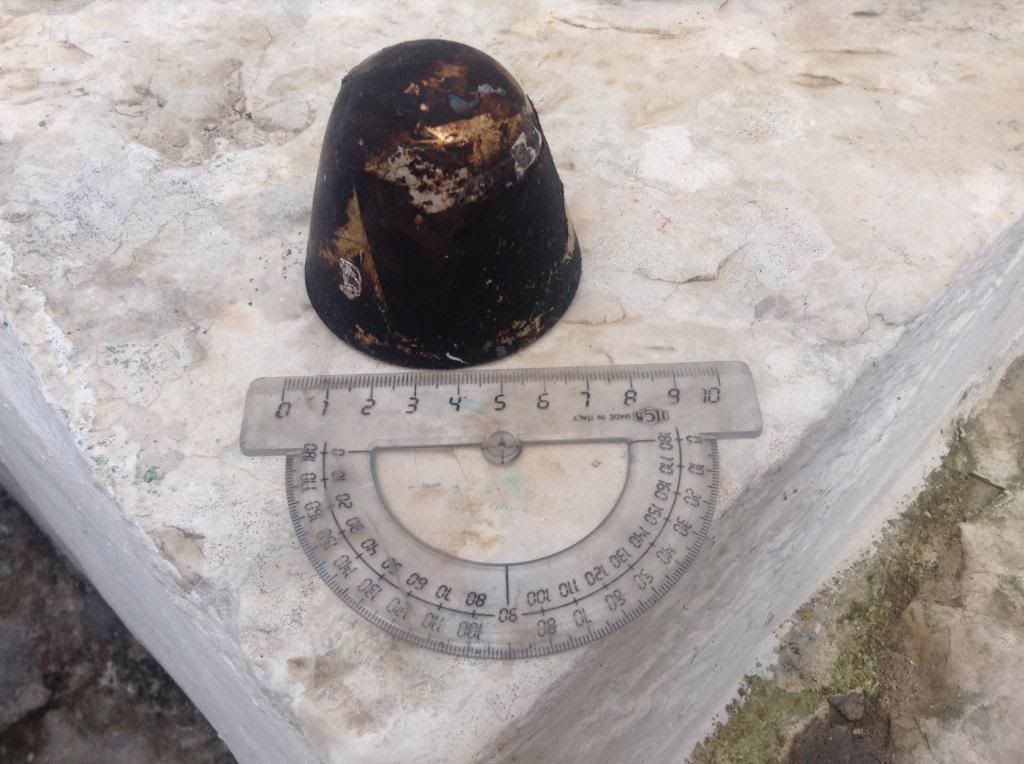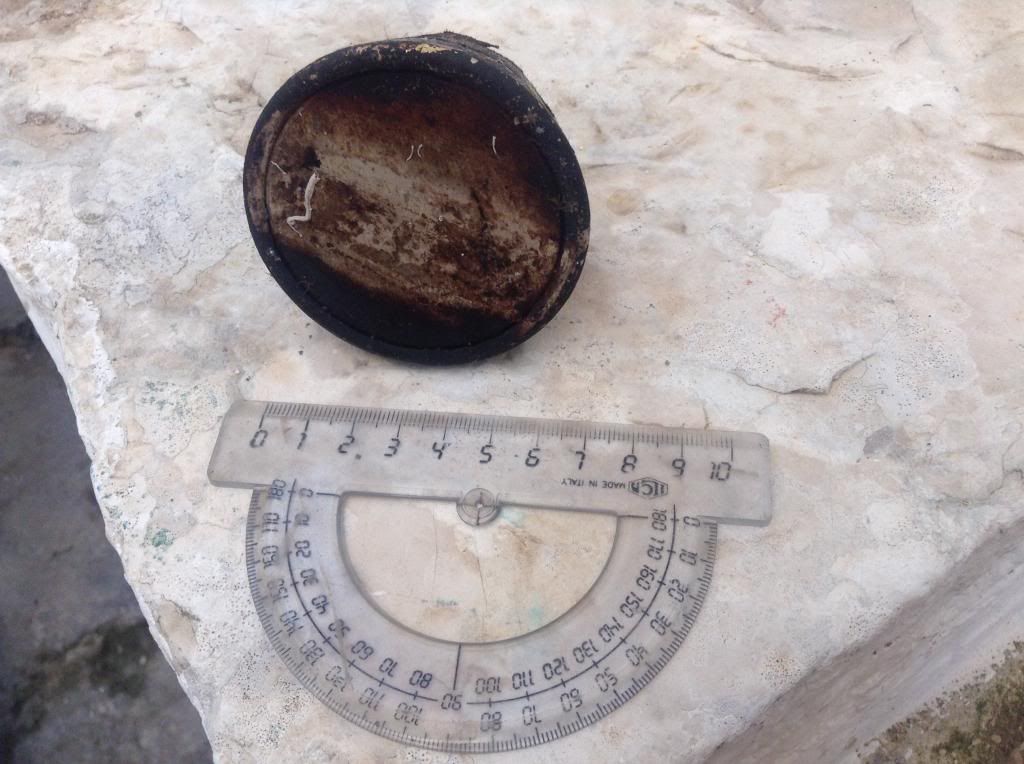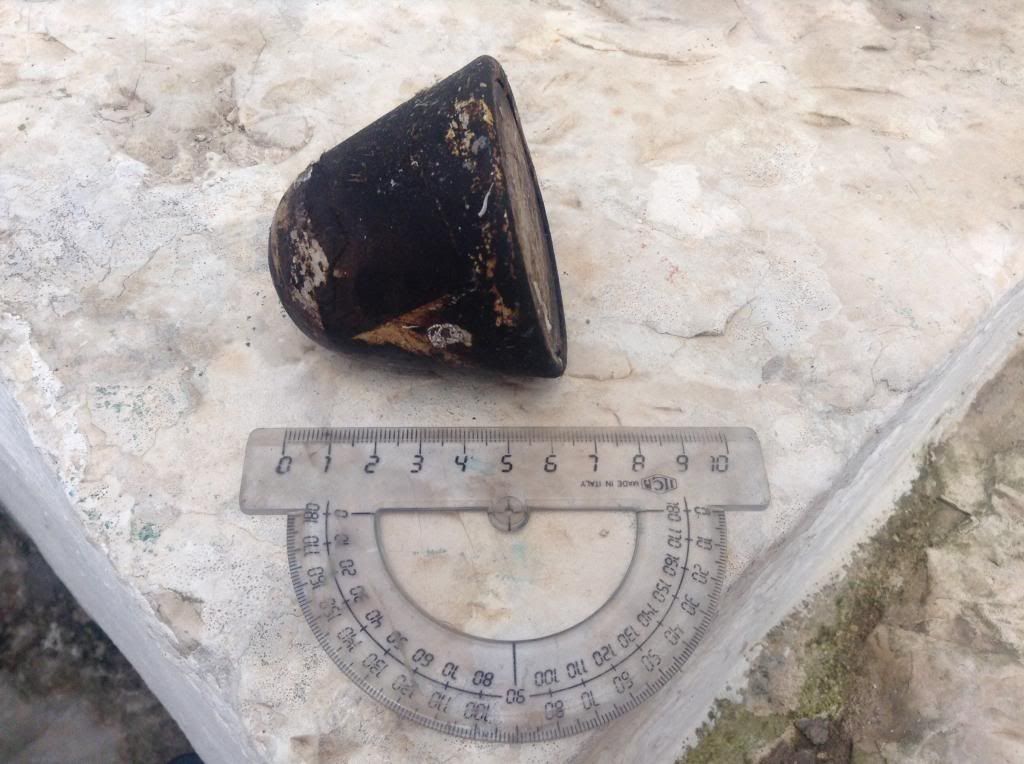
mtskull
-
Posts
310 -
Joined
-
Last visited
Content Type
Profiles
Forums
Gallery
Blogs
Events
Articles
Store
Downloads
Posts posted by mtskull
-
-
The little device mentioned in the previous note has been partially cleaned and this has revealed some engraved or stamped writing on it. Unfortunately, an interesting part of the writing has been worn away. The Manufacturer’s name appears to be “Hulco” but the interesting part after that is not readable. Anybody got any ideas? And has anybody identified what it is for?
OK, the top parts of first three letters of the second word are indistinct but I'll eat my hat if the whole thing doesn't read "HULCO ATOMISER".
-
Very nice. How will you ensure that the brake rings are concentic with the hubs? Have you access to a lathe big enough to machine them while bolted to the wheels, or is there a means of centring them after they are fitted?
-
Very interesting photos; I always enjoy the callenge of identifying the aircraft types!
I didn't recognise the aircraft in the Querrieu photo but that biplane tail arrangement is pretty unique in a relatively small aircraft and identifies it as a Hannover CL.II, CL. III or CL IIIa (impossible to say which just from the photo of the fuselage, as the main differences were in the engine and wings). I had hoped that differences in the tailplane struts might provide a clue, however I have since found enough photographic evidence to demonstrate that either arrangement could be fitted to both CL.II and CLIII, so no help.
There's not a lot to go on in the East African photo with just the nose peeping out but again, there's a pretty distinctive feature in the double nose wheel; the shape of the nacelle suggested Farman to me, and so it proves: it's a Farman H.F. 27, as used by 26 (South Africa) Squadron, RFC, during the East African campaign.
-
I'm intrigued by the wheel bearing arrangement; I would have expected the bronze bush to be a press fit in the wheel and to be free to turn on the stub axle, however the presence of a grease groove in the wheel suggests that the opposite is true.
Is this the case, or will the bush be free to turn on the stub axle as well?
Superb work as ever; I am always looking forward to the next instalment!
-
Well, you are nearly correct, you are only a few years too early, as on June 28, 1926, Benz & Cie. and DMG merged and became the Daimler-Benz company, and only then baptized all of its automobiles,Mercedes Benz. Before that they were known as BENZ, as is the WWI car in the glass negative.
Regards Rick
Vehicles branded "Mercedes" were produced from 1900 onwards; however you are right about the car in the photo and I stand corrected.
There are detail differences but it looks very like the Benz 18/45 illustrated here:
http://www.mbca.org/star-article/march-april-2011/automobiles-benz-and-mercedes-1908-1925
-
I'm not expert enough to specify the model, but I am certain that this is a Mercedes.
Many points of similarity with this:
http://upload.wikimedia.org/wikipedia/commons/3/3e/Old_Mercedes-Benz_pic1.JPG
and this:
-
I have a lovely Mk I ferret.
I used to use it a fair bit.
I then dry stored it for 6 years.
I went out to service it and clean it up ready to use again this year and found engine would not turn (I was not stupid enough to service everything and just hit the starter and hope) - I tried to turn it via the starting handle to distribute the oil in the engine (as those of you who know, it is a dry sump lubrication system).
Well, it did not turn over and I stripped the starting handle drive teeth, so you know I gave it a fair effort.
I have tried to turn it via the crank shaft pulley nut, but I felt it was not going to work and could feel the nut thread trying to strip, so I stopped.
SO...... I have a beautiful Ferret in all respects that was put away carefully, but engine so far is showing it won't turn...
what do you suggest I do now to get the old girl going?
Start by removing the spark plugs and pouring diesel into the cylinders. Leave it a few days and try again with the crank pulley nut.
-
Magnificent!
-
One of the next jobs will be the sealing of the petrol tank with tank sealer.
A word of warning: Make sure that you use a tank sealer that is specified as resistant to ethanol. These are expensive, but many of the cheaper tank sealants which are available were designed many years ago, when petrol did not contain ethanol. Today, nearly all petrol has ethanol added to it, which attacks the sealant and you end up with a leaking tank full of a nasty grey mess. :cry:
-
I would agree with it being French: -the shading of the roundels corresponds with b&w photos of known French aircraft, assuming that the wings in the background do actually belong to the fuselage on the trailer.
This one has, so far, defied my attempts to identify the type, although it definitely is not the same as the aircraft in the second photo, which I am pretty sure is a Sopwith one-and-a-half strutter (British made, but also supplied to the French).
One clue is that there appear to be at least three undercarriage wheels, plus a further tyre, which might suggest a larger, possibly twin-engined aircraft.
-
Absolutely nothing to give from an expert view, but I'd guess it's some sort of ballistic cap off a 75mm or greater round. A ballistically - efficient round will not be efficient in penetrating armour, so that by the Second World War you'd see anti-tank rounds that were Armour - piercing, Capped, Ballistic - Capped. The payload had a flat surface to efficiently transfer energy from round to target and a cap that would protect the round from breaking up on the armour, with a further ballistic cap to make it fly better, further faster and more accurately.
However, an APCBC round would be solid shot with no explosive content, so I don't think it would have been of any use blowing up the wreck. No help at all.
I know the Luftwaffe converted Stukas to tank-busters by adding ever-greater-calibre guns under the fuselage. I am sure someone can confirm to me that Beaus never went through the same concept and the aircraft in question might have been such a tank-buster?
From what is known of the aircraft and the circumstances of its loss, we can be fairly certain that it was equipped with the standard Beaufighter T.F. X armament of four 20mm cannon and eight rockets.
The gun emplacement from which the munitions were said to have been obtained was equipped with four Krupps 105mm guns.
-
I have re-posted this here, having originally posted in the aviation section; Any help identifying this item would be much appreciated.
This object was recovered (legally) from the crash site of a Bristol Beaufighter shot down onto the sea off the Greek island of Kefalonia in 1944 but as far as I can ascertain it doesn't belong to the Beaufighter.
One clue to its origin may lie in the story that, post war, the local people wanted to recover scrap metal from the aircraft and blew it up using munitions scavenged from an abandoned German gun battery; possibly not everything they used detonated successfully.
The scale on the ruler is in centimetres; the object itself appears to be aluminium. Another, damaged, example (which we left on the sea bed) appeared to be packed solid with a bluish, powdery substance.
My thoughts are that it may be a component from an artillery shell; can anyone else offer any suggestions?
P.S: In the interests of safety, this has been put back where it came from.
-
Recovered (legally) from the crash site of a Bristol Beaufighter shot down onto the sea in 1944. Any help identifying this item would be much appreciated. The scale on the ruler is in centimetres; the object itself appears to be aluminium but with some kind of bitumastic coating. Another, damaged, example (which we left on the sea bed) appears to be packed solid with a bluish, powdery substance. My thoughts are that it may be a component from an emergency landing flare or even the self-destruct incendiary device but any suggestions or definitive information most welcome.
-
Stow Maries , Great War Society, Sopwith Pup and Motor Transport.
Photo Credit: Steve Le Grys
[ATTACH=CONFIG]90975[/ATTACH][ATTACH=CONFIG]90976[/ATTACH][ATTACH=CONFIG]90977[/ATTACH]
Military vehicles in a spot-on authentic setting, being used for the same purpose as they were back in the day; Absolutely bl**dy brilliant!
-
I must admit to being among those who, at the start of your project thought "Oh dear".
I will now eat humble pie and say that you have created a magnificent vehicle that really captures the spirit of the original.
Nice one.

-
Fascinating. Took me some time to I.D. the aircraft; it is a Martinsyde Elephant, quite a rare beast, only 270 produced.
In addition to France, the Elephant also saw service in Palestine and Mesopotamia (now Iraq). The desert setting in the photo suggests that it was taken in one of these countries.
-
I have seen an engine (admittedly a more modern one) show good compression on all four cylinders under a cranking compression test but which, when started, would only run on three. I followed my instinct and took the head off and the problem turned out to be due to a partially failed head gasket which would hold the cranking pressure but not the combustion pressure.
-
The rear axle could have been top half worm drive, a la Dennis.
Chassis construction is pure International and matches a photograph of an early such [wooden wheeled, solid tyre] truck.
Berliet lorries were generally chain drive. Both the French Berliet and American Liberty trucks had 7 spoked cast wheels.
This is quite a conundrum, to be sure.
Those front chassis members are certainly Continental but as nothing on the rear chassis matches, are most likely not associated with the rest of the remains except in that they ended up in the same pile.
There are many photos of Liberty trucks on the web but, apart from having 7 spokes, the wheels don't resemble these ones.
As regards Berliet, I stand to be corrected if someone comes up with evidence to the contrary but, so far as I can ascertain, the CBA was the only model of lorry that Berliet made between the outbreak of WW1 and the end of the 1920's; as it used chain drive that would seem to rule out Berliet as the origin of these remains. There are also differences in the front axle and, although Berliet CBA wheels do strongly resemble the wheels in the photo, there are differences when subjected to close examination.
Sorry if this sounds rather negative; I would dearly love for someone on this forum to get to the bottom of this mystery but all good detective work begins with a process of elimination.
-
With those 7 spoke wheels Berliet does look to be a likely contender. Not sure which model though. Not the CBA as that was chain drive. Something much smaller. Not as early as 1906 either as I would think that the wheels would have been wooden.
If Wikipedia is to be believed, the CBA was the only model of lorry produced by Berliet during WW1 and through the 1920's, which would seem to rule out Berliet as the identity of these remains.
Not directly relevant to this thread but something I came across whilst trying to solve the mystery; a Berliet Anti-Aircraft lorry in Romanian service: http://mailer.fsu.edu/~akirk/tanks/romania/Rom-berliet.jpg
Note the 8-spoke wheels!
-
I can't hazard a guess yet as to what this is, but I'm pretty sure it is not a Berliet, although the wheels bear a very close resemblance. Weren't Berliet trucks of this era chain drive?
Looking very closely at the front axle, I think it is simply dropped downwards; the appearance of being curved forwards being an illusion caused by the curvature and the viewing angle.
-
is it possible we are barking up the wrong tree and it not off a radial? a fixed inline engine could have been built with a valve in the piston and still have just one exhaust valve perhaps ????
Possible, but the whole and entire point of using either the "inlet valve in piston" or the monosoupape arrangement was as a solution to the problems of fuel/air induction which exist in Rotary (not Radial) engines.
These problems don't exist in more conventional engines, so there would be no reason to put up with the inherent limitations and inefficiencies.
I did wonder whether the cylinder might have been from a Gnom stationary engine, distant ancestor of the Gnome Rotary, but when I eventually found a photo, there was no resemblance at all.
Just to try to match another aspect of the cylinder's specification, please could you tell us its weight?
-
Let's recap what we know for certain, in that we are looking at a cylinder that has the following characteristics:
a) A single port at the top of the cylinder and a bracket which is consistent with a rocker arm support.
b) Two threaded holes, consistent with spark plug holes, inclined at approx 45deg.
c) A row of holes at the bottom of the cylinder
d) Bore 138mm, length of cylinder 265mm
e) 20 fins, increasing in diameter from the base and decreasing again near the top
f) The cylinder appears to have been machined from solid
I believe that we can say for certain that you have a cylinder from a rotary aero engine of single valve ("monosoupape") design. As for the date, the fact that this type of engine became obsolete around the end of WW1 places it firmly in that era. The holes in the base are a tantalising clue; if we accept that they are transfer ports, then the engine is a true "monosoupape" and therefore post-1913; if these holes are not actually transfer ports, the the engine must have been of the "inlet valve in piston" type, which dates it to very early WW1 era, or even pre-war, although there was probably a period of overlap when both types were being produced.
As for the maker, that is more difficult. Let us consider the known features:
a) is consistent with known illustrations of Gnome engines
b) is, I believe, inconclusive. I have seen illustrations of Gnome engines with single and with twin spark plug arrangements and also with the plugs set at 90 deg. and at 45 deg. I haven't found reference to an engine with twin plugs set at 45 deg, but that isn't to say they didn't exist.
c) is inconclusive unless it can be determined whether or not they are, in fact transfer ports. Gnome specification suggests that there should be 36. How many are there on this cylinder?
d) is inconclusive in determining the stroke, however the bore does not match any specification for Gnome engines that I can find.
e) exactly matches some Gnome engines
f) was a method of manufacture pioneered by Gnome and almost unique in its day, however as it follows that licence builders and copyists would have employed the same method, it must be regarded as inconclusive.
There is some evidence pointing to this being a Gnome; the company introduced this type of engine but given that it was then widely licence built and/or copied by other manufacturers (who in all probability introduced modifications and variants of their own), the exact manufacturer will probably remain a mystery.
That said, what a cracking piece of history to own! :-)
-
Here are some more photos , havnt got the ringer out as its corroded in , have put some oil on and will have another try tomorrow.[ATTACH=CONFIG]88618[/ATTACH]
Those holes would possibly correspond to the transfer ports as shown in this drawing:
http://upload.wikimedia.org/wikipedia/commons/8/8f/Gnome_Monosoupape_fig1_cylinder.jpg
That could only work, however if there had once been a further portion of cylinder below the ports, otherwise the piston would have to come entirely out of the cylinder in order to uncover them. This would make for an unusually tall cylinder and an exceedingly long stroke, so I would be inclined to believe that they served another purpose.
-
There's a drawing of a Gnome cylinder cross-section here:
http://www.pilotfriend.com/aero_engines/aero_soupape.htm
and a photo here:
http://upload.wikimedia.org/wikipedia/commons/4/40/Gnome_Omega_OW.jpg
Again, they differ from yours in some details but they demonstrate that the spark plug holes in some engines were angled at about 45 degrees.









WW1 Thornycroft restoration
in Pre WW2 vehicles
Posted
[quote name=
The date of the patent, 9th May 1927, also answers your question as to which manifold , cast or alloy, is the oldest.
The ball races are lubricated by a lubricator 17.
]I can remember aspects of this design repeated in the 1950/60's as a result of sharp fuel price rises stemming from the Suez Crisis.
John
This manifold and associated "short pipe" give a fascinating snapshot of history, although with the greatest of respect, I don't see how it is possible to determine the date of the manifold according to the date of an accessory that was probably fitted after manufacture.
The mention of a lubricator may provide a clue to the purpose of the pipe union fitted to the manifold?
The extra flange with offset studs suggests an adaptor to allow the fitting of a later carburettor.
The oil crisis of the 1970's also gave rise to a plethora of similar devices claimed to improve fuel economy. They all had one thing in common: they didn't work, or if they did it was at the expense of performance.
I suspect that the "Hulco Atomiser" is no different; unless the carburettor was grossly inefficient to begin with, any benefit gained from better atomisation was likely to be more than offset by the detrimental effect of placing an obstruction in the intake tract. A similar trade-off of performance against economy could have been achieved by simply restricting the throttle so that it couldn't open fully.